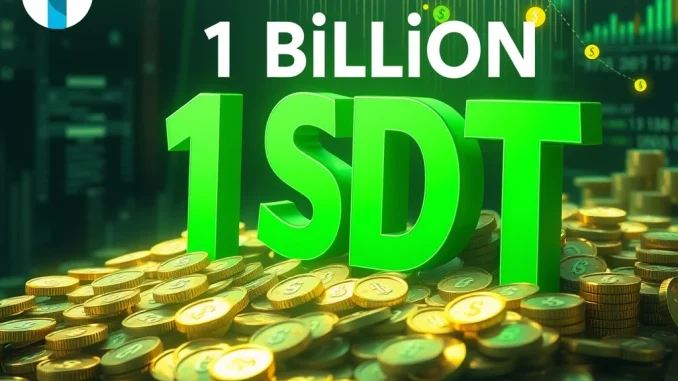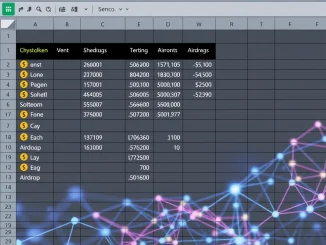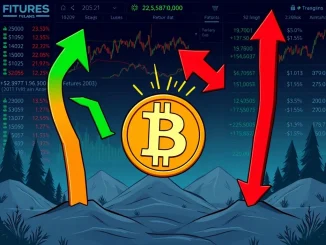
The cryptocurrency market is always buzzing with activity, and recent news from the stablecoin giant, Tether, has captured significant attention. According to a report by the blockchain tracking service Whale Alert, a staggering 1 billion USDT has just been minted at the Tether Treasury wallet. This event is more than just a number; it’s a signal that prompts questions about market dynamics, liquidity, and the role of stablecoins in the broader crypto ecosystem. For anyone tracking market movements, understanding the implications of such a large USDT minted event is crucial.
What Does 1 Billion USDT Minted by Tether Treasury Actually Mean?
When Whale Alert reports a large amount of USDT being ‘minted’ at the Tether Treasury, it signifies the creation of new Tether tokens. Think of the Tether Treasury wallet as an inventory or holding account for Tether. Minting tokens here is typically the first step before they are authorized and issued onto specific blockchains (like Ethereum, Tron, Solana, etc.) to be distributed to exchanges or institutional clients.
Here’s a breakdown of what the report implies:
- New Supply Created: 1 billion new USDT tokens have been generated.
- Location: These tokens currently reside in a wallet controlled by Tether itself (the Treasury).
- Purpose: While the exact immediate purpose isn’t always disclosed at the time of minting, Tether often states these are for ‘inventory replenishment’ or ‘future issuance’ based on anticipated demand. They are not immediately released into the circulating supply available on exchanges.
This process is part of how Tether manages the Stablecoin supply to meet demand from users and platforms needing a stable digital dollar equivalent.
How Does This Massive Stablecoin Supply Affect the Crypto Market?
A significant increase in the potential Stablecoin supply, like this 1 billion USDT mint, often sparks discussion about its potential Crypto market impact. While a direct cause-and-effect relationship is debated, the availability of large amounts of stablecoins is generally seen as a positive factor for market liquidity.
Consider these potential effects:

- Increased Buying Power: More USDT available means more capital that *could* potentially be used to buy volatile cryptocurrencies like Bitcoin and Ethereum on exchanges that trade against USDT pairs.
- Liquidity Injection: Large amounts of stablecoins facilitate easier and larger trades, potentially reducing slippage on exchanges.
- Signal of Demand: While Tether maintains mints are for inventory, some market observers interpret large mints as Tether preparing for anticipated demand from institutional players or exchanges who need USDT to facilitate large trades for their clients.
- Market Sentiment: Historically, large USDT mints have sometimes coincided with or preceded upward market movements, leading some traders to view them as a bullish signal, though correlation is not causation.
It’s important to differentiate between tokens minted at the Treasury and tokens actually issued into circulation on specific blockchains. The real market impact comes when the USDT moves from the Treasury wallet to exchanges or large OTC desks.
Is This 1 Billion USDT Destined for Immediate Use?
Not necessarily. As mentioned, minting at the Tether Treasury is usually the first step. Tether’s standard practice involves minting tokens and holding them in their Treasury wallet. They are then authorized and issued onto specific blockchains as needed to fulfill redemptions or new requests from verified customers (like exchanges or large traders).
Tether has often stated that these large mints are part of their operational process to ensure they have sufficient ‘inventory’ across various blockchains to meet future demand without delay. So, while the tokens exist, they aren’t instantly flooding the market. Their movement out of the Treasury wallet onto specific chains is a more direct indicator of imminent market activity.
Understanding Stablecoin Supply and Its Significance
Stablecoins like USDT are a cornerstone of the cryptocurrency market. They provide a stable store of value that allows traders to move in and out of volatile assets without converting back to traditional fiat currency, which can be slower and involve more fees. The total Stablecoin supply is a key metric market analysts watch.
Here’s why the overall supply matters:
| Metric | Significance |
|---|---|
| Total Supply | Indicates the overall amount of stable value available within the crypto ecosystem. |
| Circulating Supply | Represents tokens actively being used on blockchains and exchanges. |
| Treasury Balance | Shows tokens held by the issuer for future distribution or reserves. |
| Supply Changes (Mints/Burns) | Reflects demand for stablecoins and potentially future market activity. |
A growing Stablecoin supply can indicate increased participation in the crypto market, as more capital is being onboarded into digital assets, even if just temporarily held in a stable form.
Key Takeaways from This Tether Treasury Event
The minting of 1 billion USDT is a significant event in the stablecoin world. While it doesn’t guarantee an immediate market surge, it adds substantial potential liquidity to the ecosystem. It reinforces Tether’s dominant position in the stablecoin market and highlights the ongoing demand for stable digital assets.
For market participants, this event serves as a reminder to:
- Watch for movements of this USDT from the Treasury wallet to exchanges.
- Consider the overall increase in potential buying power available in the market.
- Understand that stablecoin mints are part of the infrastructure supporting crypto trading.
In conclusion, the USDT minted event at the Tether Treasury is a notable development, injecting a potential 1 billion USDT into the system’s inventory. Its ultimate Crypto market impact will unfold as these tokens move through the ecosystem, but it undeniably represents a significant increase in the available Stablecoin supply, reinforcing the infrastructure for future market activity.



